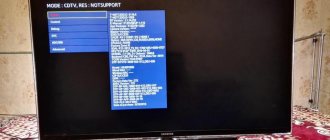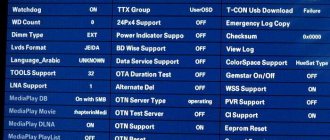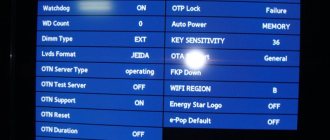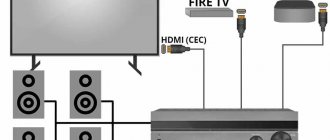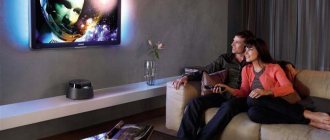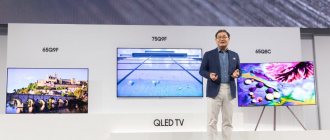PQI (Picture Quality Index) technology is an index introduced by Samsung to evaluate the picture quality on Smart TVs. This is done to clearly show consumers the manufacturer’s interest in the quality of its products. The system is clearly ranked. The buyer can evaluate the quality of the picture on the screen by the corresponding index value from 100 to 2700. However, if a device model has a rating of 100, this does not mean at all that the image on the screen will be worse, Samsung simply considers this value as a starting point in the rating of manufactured models TVs.
Features of the technology
There are certain criteria that play key roles in making an assessment. They are the following:
- screen resolution;
- color;
- brightness contrast;
- movement;
- noise suppression.
Screen resolution is a technical parameter that shows the degree of detail of the image. In this case, we are talking specifically about the digital image inherent in all modern smart TVs from Samsung. The parameter is represented by 2 numbers: the horizontal and vertical dimensions of the image in pixels. Popular resolutions today are HD – 1280x720 (720p), Full HD – 1920x1080 (1080p), Ultra HD – 3840x2160 (4K).
The latter appeared relatively recently, but is already rapidly gaining popularity in the premium segment. 4K resolution gets its name from the fact that there are 4,000 pixels horizontally. In today's market, this is the optimal image, providing a high degree of clarity in a standard 16:9 screen format.
When calculating technology 1300 PQI and higher, engineers calculate the quality of image color display to be in maximum compliance with standard RGB colors (red, green, blue). The higher the degree of compliance, the higher the final score in the technical characteristics of the product. In addition, the screen must provide the user with a “rich” image, both static and dynamic.
Samsung uses Quantom Dot or Purcolor technology.
There is a slight difference between these options in terms of color rendering, but both of them produce a colorful picture that the consumer will definitely enjoy.
The brightness contrast parameter helps to display shadows, penumbra, clarity of lines and contours. The user sees rich white and black colors. In addition, the screen should not have any highlighted corners or areas with oversaturated blacks that stand out from the rest of the color balance of the picture. This can be seen especially effectively with the help of tests (certain colors are displayed on the screen one by one). It is highly recommended to check the screen in complete darkness.
Motion on a TV is expressed in frames per second. The more of them in the given time, the higher the PQI score will be. The user sees smooth movements of all characters in the picture with a complete absence of shaking effect. This allows you to relax as much as possible when watching movies.
Noise reduction is another important criterion for image quality. Many people associate it with the audio output of the TV, but this parameter shows the level of presence of third-party effects in the image details. They can be light and dark areas in the picture. Thanks to innovative technology from Samsung Clean View Samsung, the noise suppression effect has become significantly higher.
Visually, it will be quite difficult for a buyer to determine the difference between TV models that have different PQI indexes. Many people argue that this is just a deliberate move by Samsung marketers in order to interest potential buyers of their products, but the clear certification of the index suggests otherwise.
What is screen refresh rate
To understand which scan is better, you need to know what the refresh rate of an LCD TV screen is. This characteristic means how many frames per second the panel can display and is measured in Hertz (Hz).
The higher this value, the better the image will be when playing dynamic scenes. Thus, from television receivers with a frequency of 50 Hz and 100 Hz, you need to select a second device. 50 Hz (60Hz) is the minimum frame rate found on inexpensive TVs. It is intended for television content that displays 50 frames per second. New TV models began to add one intermediate frame, so their frequency became 100 (120) Hz. Modern television panels have a frequency of 200 Hz and higher. In them, digital processing adds three (or more) intermediate frames.
It is believed that for comfortable viewing of dynamic scenes (football, car racing, etc.) it is necessary to purchase panels with a frequency of 200 Hz.
The difference between a 200 Hz and a 100 Hz display will be noticeable, but the human eye is rarely able to see the differences between 200 Hz and 300 (or more).
Interesting Facts
The technology is a development of the earlier CMR (clean motion rate) index - the image Hertz index. It shows the quality of scenes in motion on the TV screen. None of these technologies can objectively show the actual picture quality. Samsung representatives keep the formula for calculating the PQI index a deep secret, regularly increasing this indicator in new models of their products. If you look visually at images of other brands of smart TVs, it is quite difficult to feel the difference.
To find out using 1300 pqi technology how many hertz an image has, you need to pay attention to the same CMR index. The manufacturer ranked the presented value in the range of 200, 400, 600 and 1200 Hz. These indicators were relevant until 2015. In 2016, Samsung developed its own method for calculating image quality on the screens of its products.
This is how the PQI assessment technology appeared. It goes beyond the picture hertz values in static and dynamic scenes, since this value has already settled at the level of 1200 Hz (complete absence of screen flickering).
Interestingly, the PQI index is not always and not always declared by Samsung in its technical specifications. For example, in America it is replaced by Motion Rate. This parameter shows the number of image frames per second. At the same time, on TVs without a 3D function - from 100 to 200 Hz, with a 3D function - 200 Hz and higher. For this reason, when buying a TV from the USA, you should not be surprised by the lack of an index presented.
Many experts argue that the value of the described index is determined by the factory settings of the picture parameters on the TV. Through testing and careful development of many leading models of the presented products, no complex technologies are used when calculating and declaring PQI in the documentation of their products. Therefore, skeptics argue that highly qualified Samsung marketers came up with such an assessment in order to interest consumers in their product.
Picture Quality Index
From the decoding of the abbreviation, it becomes obvious that we are talking about the image quality index, thanks to which Samsung has compiled a rating of TV devices. It presents exclusively TVs from this manufacturer, each of which is assigned a certain number of points.
This is a cumulative value that takes into account all technologies that improve color reproduction, natural whites, black depth, contrast, detail, and clarity.
Previously, instead of PQI, the universal index CMR (Clear Motion Rate), measured in Hertz (Hz), was used, but in 2021 the South Korean brand introduced its own unit of quality measurement.
In the USA and some Western countries, the above value is still used to describe the number of frames/sec and is mandatory, fixed at the legislative level, since buyers must receive maximum information about the equipment they are purchasing.
Popular TV models with PQI
Today, there are a huge number of Samsung TV models with this image quality rating. The most popular models are from 39 to 50 inches. This range in size makes it easy to install the presented products in a kitchen, cottage or large room.
Vivid examples of such TVs from Samsung are the following models:
- UE40MU6100UXUA;
- UE32N5300AUXUA;
Products with a 3D function are not considered for the reason that modern models from the presented manufacturer already have their own assessment of the described technology. The most notable model is the UE40MU6100UXUA, which has Ultra HD images on a 40-inch screen. This ratio allows the consumer to enjoy a high-quality and clear picture with a huge variety of colors.
The TV model UE32N5300AUXUA has a Full HD image on a 32-inch screen. The ideal ratio of high-quality images with compact dimensions of the product. This makes it easy to install in a kitchen, garage or small space. What does pqi technology mean on TV? 500 fully justifies the affordable cost of a digital technology product. For this reason, the model is most popular among those who are accustomed to saving money but purchasing quality products.
Samsung UE43NU7472 TV is an excellent installation option in the living room of a city apartment. A 43-inch diagonal screen with Ultra HD picture resolution can satisfy the tastes of even the most demanding film fan. The main emphasis is on the level of focus and level of detail.
Criteria
Let's return to PQI. 2000 – what is this number? In fact, points can be different - from 100 to 2700. How are they awarded? The following factors are taken into account:
- Resolution (number of pixels horizontally/vertically) – HD 720, FHD 1080, 4K, 4K with HDR support, etc. The higher the resolution, the more it affects PQI;
- Color rendition is determined by the presence of Pure Color / QuantumDot technologies in the TV. Both algorithms contribute to special image processing so that the viewer sees a realistic picture, as if looking out of a window;
- Contrast - in simple words, the more millions of shades that separate black and white, the deeper the transmission of shadows and halftones. And even a black cat in a dark room can be seen;
- Smoothness of movement - the number of frames displayed per 1 second is the most important value affecting PQI (200, 400, 1400...). Thanks to the latest technologies, we can observe realistic dynamics, without jerks, distortions, or jitters.
Football fans are especially delighted with this, who watch matches on TV and get the opportunity to enjoy a live picture, as if they were seeing it all with their own eyes on the field, and not on the screen.
- Noise suppression. Unfortunately, while not every channel or source provides high-quality content, HD looks so-so on a large diagonal. To hide and smooth out unnecessary noise, the TV has a suppression level setting.
If we add together all the properties listed above, we will get some value. Of course, you won’t be able to calculate it yourself. Samsung does this for us.
Many online stores use PQI in the description of Samsung TVs, which often confuses potential customers:
It is worth noting that if you put two models with different indexes next to each other, not everyone will be able to visually notice the differences in the image. Because there can be a very fine line between 1900 and 2400. Therefore, you should not worry too much and pay special attention to this figure. It’s better to analyze reviews, watch reviews on Youtube and form a specific idea about the product in your head.
Review of Samsung QLED 2021 - 4K and 8K quantum dot TVs
Review of Samsung QLED 2021 - 4K and 8K quantum dot TVs
May 8, 2020
Samsung offers a huge number of TVs, which are difficult to understand even for a technically savvy person. We'll talk about the new QLED TV series introduced in 2020 - what they have in common, and what features each model has.
QLED: Picture Realism and Reliability
The main thing that all QLED TVs have in common is the screen type. QLED means that the display consists of several layers, and between the layer of LEDs and the liquid crystal pixel matrix there is a layer of quantum dots. They expand the color range, increase brightness and do not distort the structure of the light that comes from the LED backlight. As a result, compared to traditional LED TVs, QLED impresses with its rich color reproduction and smoothness of shades.
QLED TVs compete with expensive OLEDs, which lack LED backlighting. The OLED pixel matrix already includes organic light-emitting diodes, so each pixel lights up independently. You can argue about image quality, but only until the conversation touches on durability.
Despite all their advantages, OLED panels have one significant drawback - over time they “burn out,” that is, the TV screen continues to show a trace of the image. In principle, this cannot happen with QLED panels, and therefore Samsung guarantees that for 10 years the QLED TV will delight you with the highest image quality.
Sum of high technology
But a modern TV is not only a screen and a DVB-T2 receiver for receiving over-the-air channels, as it was before. Inside QLED TVs, super-powerful Quantum processors work, preparing content in such a way that the image is as close to reality as possible, and the sound immerses you in what is happening on the screen.
So, all Samsung QLED TVs of the current 2021 received the following technologies.
- AI scaling.
Despite the breakthrough in visual technologies, most of the content we watch is still presented at most in Full HD resolution. When transferring such an image to 4K and 8K screens, it needs to be scaled, because there are many more pixels on the display. To “stretch” the image, Samsung QLED TVs use artificial intelligence. It doesn’t just increase the area of the frame, which would inevitably affect the quality of the picture, but literally “finishes” and restores the image, adding pixels and details.
- Adaptive picture mode.
Probably, few of us are ready to allocate a separate room for TV, where there is neither day nor night, neither sunny nor cloudy weather. But the picture on the screen also depends on external conditions. Samsung QLED TVs monitor what's happening in ambient light and immediately adjust the picture to keep it bright and vibrant.
- Active speech amplifier.
If the TV is in the kitchen, where suddenly the soup is bubbling, the mixer is whirring and the washing machine is spinning, it will independently increase the volume of its voice so that you do not miss a word.
- Dynamic tone mapping.
Almost every scene in the film has extremely dark and extremely light areas. To bring out details in dark areas, you need to increase the brightness. But then the light areas will turn into white spots. And vice versa - details in light areas require a decrease in brightness, which will lead to the disappearance of shadows.
The HDR dynamic range feature aims to solve this problem. But since scenes in videos are constantly changing, Samsung has improved this technology by offering HDR10+ format. Such content includes not only video and audio streams, but also an array of metadata, based on which the TV adjusts the brightness in the right areas on the fly. The result is excellent detail and the widest tonal range.
54.6″ Samsung UE55KU6100, 54.6″ LG 55UH650V
Comparison between: 54.6″ Samsung UE55KU6100, 54.6″ LG 55UH650V Home
| Samsung UE55KU6100 | LG 55UH650V | |
| Series | KU6100 | UH650 |
| Alternative model name | UE55KU6100WXXH UE55KU6100KXXC | — |
| Size/Class | 54.6in | 54.6in |
| Diagonal | 1388 mm 138.8 cm 54.6457 in 4.5538 ft | 1388 mm 138.8 cm 54.6457 in 4.5538 ft |
| Width | 1209.75 mm 120.975 cm 47.6278 in 3.969 ft | 1209.6 mm 120.96 cm 47.622 in 3.9685 ft |
| Height | 680.483 mm 68.0483 cm 26.7907 in 2.2326 ft | 680.4 mm 68.04 cm 26.7874 in 2.2323 ft |
| Radius of curvature | 4200 mm 420 cm 165.354 in 13.7795 ft | — |
| Matrix manufacturer | — | LG Display |
| Matrix model | — | LC550EGE-FJM3 |
| Matrix type | V.A. | IPS |
| Matrix bit depth/bit depth/color depth | 8 bit | 10 bits (8 bits + FRC) |
| FRC | — | Yes |
| Display colors | 16777216 colors 24 bit | 1073741824 colors 30 bit |
| Aspect Ratio/Screen Format | 1.778:1 16:9 | 1.778:1 16:9 |
| Permission | 3840 x 2160 pixels Ultra HD (UHD) / 4K / 2160p | 3840 x 2160 pixels Ultra HD (UHD) / 4K / 2160p |
| Pixel pitch | 0.315 mm 0.0315 cm 0.0124 in 0.001 ft | 0.315 mm 0.0315 cm 0.0124 in 0.001 ft |
| Pixel Density | 81 ppi 31 ppcm | 80 ppi 31 ppcm |
| Screen area | 92.26 % | 92.06 % |
| Backlight | — | Edge LED |
| NTSC (1953) | — | 68 % |
| DCI P3 | — | 84 % |
| Brightness | — | 390 cd/m² |
| Static Contrast | — | 1100 : 1 |
| HDR | HDR | HDR Pro |
| Horizontal viewing angle | — | 178 ° |
| Vertical viewing angle | — | 178 ° |
| Minimum response time | — | 9 ms 0.0090 s |
| — | RGBW structure - 2880 (RGB) + 960 (W) |
| Vertical frequency (digital interface) | 50 Hz / 60 Hz | 50 Hz / 60 Hz |
| Technology | Picture Quality Index | Picture Mastering Index |
| Interpolation value | 1400 | 1700 |
| Interpolation unit | PQI | PMI |
| 220V | 220 V - 240 V | 220 V - 240 V |
| AC frequency | 50 Hz - 60 Hz | 50 Hz - 60 Hz |
| Power consumption (off) | — | 0.3 W |
| Power consumption (standby) | 0.3 W | 0.3 W |
| Energy consumption (Eco mode) | — | 68 W |
| Power consumption (maximum) | 205 W | — |
| Energy efficiency class | A | A+ |
| Width | 1241.7 mm 124.17 cm 48.8858 in 4.0738 ft | 1240 mm 124 cm 48.8189 in 4.0682 ft |
| Height | 718.6 mm 71.86 cm 28.2913 in 2.3576 ft | 721 mm 72.1 cm 28.3858 in 2.3655 ft |
| Depth | 111.9 mm 11.19 cm 4.4055 in 0.3671 ft | 60.9 mm 6.09 cm 2.3976 in 0.1998 ft |
| Weight | 16.2 kg 35.71 lbs | 16.5 kg 36.38 lbs |
| Width with stand | 1241.7 mm 124.17 cm 48.8858 in 4.0738 ft | 1240 mm 124 cm 48.8189 in 4.0682 ft |
| Height with stand | 779.3 mm 77.93 cm 30.6811 in 2.5568 ft | 776 mm 77.6 cm 30.5512 in 2.5459 ft |
| Depth with stand | 310.5 mm 31.05 cm 12.2244 in 1.0187 ft | 216 mm 21.6 cm 8.5039 in 0.7087 ft |
| Weight with stand | 17.2 kg 37.92 lbs | 16.8 kg 37.04 lbs |
| Color | Black | Grey |
| VESA mount | Yes | Yes |
| VESA standards | 400 x 400 mm | 300 x 300 mm |
| Removable stand | Yes | Yes |
| Height adjustment | No | No |
| Orientation landscape/portrait | No | No |
| Rotate (left/right) | No | No |
| Tilt (forward/backward) | No | No |
| V-shape stand | Eiffel stand |
| TV tuner | Analog (NTSC/PAL/SECAM) DVB-T DVB-T2 DVB-C | Analog (NTSC/PAL/SECAM) DVB-T DVB-S DVB-S2 DVB-T2 DVB-C |
| System on a Chip (SoC) | Jazz-L | M16 |
| Central Processing Unit (CPU) | — | ARM Cortex-A53 |
| Number of CPU cores | 4 | 4 |
| CPU frequency | — | 1000 MHz |
| Graphics Processing Unit (GPU) | — | ARM Mali-T760 MP2 |
| Number of GPU cores | — | 2 |
| GPU frequency | — | 600 MHz |
| Type of random access memory (RAM) | — | DDR3 |
| operating system | Tizen 2.4 | webOS 3.0 |
| Speakers | 2 x 10 W | 2 x 10 W |
| 2 CH down firing + bass reflex Dolby Digital Plus DTS | 2.0 CH DTS Decoder DTS-HD Ultra Surround |
| Net | LAN Wi-Fi 802.11a 802.11b 802.11g 802.11n 802.11ac Bluetooth Wi-Fi Direct DLNA | LAN Wi-Fi 802.11a 802.11b 802.11g 802.11n 802.11ac Bluetooth Wi-Fi Direct DLNA |
| Connection | 2 x USB 2.0 1 x Ethernet RJ45 3 x HDMI 2.0 (ARC; CEC) 1 x AV Composite In 3.5 mm jack 1 x Video Component In 3.5 mm jack 1 x Optical Audio Out 1 x Antenna (RF) (female) 1 x CI+ 1.3 | 2 x USB 2.0 1 x Ethernet RJ45 3 x HDMI 2.0 (ARC; CEC) 1 x Satellite In (Main; F-type female) 1 x AV Composite In (Video + L/R) 1 x AV Component In (YPbPr + L /R) 1 x Optical Audio Out 1 x 3.5 mm Audio Out 1 x RS232 (C) 1 x Antenna (RF) (female) 1 x CI+ 1.3 |
| Characteristics | Anynet+ (HDMI-CEC) Auto Depth Enhancer Auto Motion Plus Digital Clean View Extended PVR HDCP (High-bandwidth Digital Content Protection) 2.2 Light sensor Picture-in-Picture PurColor Smart View 2.0 UHD Dimming UHD Upscaling Ultra Clean View Voice command | 3D Color Mapping 4K Upscaler Active Noise Reduction Clear Voice III ColourPrime Pro Dynamic Color Enhancer HDCP (High-bandwidth Digital Content Protection) 2.2 Local Dimming PVR SIMPLINK (HDMI CEC) True Black Panel UHD Mastering Engine ULTRA Luminance |
| Graphic file formats | JPEG GIF PNG MPO BMP | JPEG MPO JPS |
| Audio file formats/codecs | AAC FLAC M4A MIDI MP3 OGG WMA WAV APE AIFF ALAC | AAC AC3 AMR AMR-WB MP3 OGG RealAudio WMA HE-AAC LPCM |
| Video file formats/codecs | 3GPP AVI ASF DivX Flash Video H.263 H.264 H.265 MKV M2TS MP4 MPEG-4 TS VC-1 VP7 VP8 VP9 VOB VRO WebM WMV | 3GPP AVI DivX Flash Video H.263 H.264 H.265 MKV QuickTime M2TS MP4 MPEG-4 TS VC-1 VP9 |
| Certificates, standards and licenses | RoHS | RoHS UL/cUL |
| Working temperature | — | 0 °C - 40 °C 32 °F - 104 °F |
| Operating humidity | — | 10 % — 80 % |
| Storage temperature | — | -20 °C - 60 °C -4 °F - 140 °F |
| Storage Humidity | — | 5 % — 85 % |
| Accessories | 3.5 mm component adapter 3.5 mm composite adapter Remote control — TM1240A | — |
The information on the site is provided “as is” without any warranties. The site is not responsible for omissions, inaccuracies or other errors in the data it publishes. Reproduction of any part of the site, in whole or in part, or in any other form, without our prior written permission is prohibited. Trademarks, logos and logos of mobile device manufacturers, hardware, software, etc. belong to their respective owners.
cookies policy | terms of use about us | contact us | news © 2021 displayspecifications.com
Video
I wanted to post a good video here with a visual explanation of the topic, but I couldn’t find a single one worthy of attention on the Internet. Mostly promotional clips praising the South Korean tech mogul's products. If you come across something interesting, I ask you to share the information in the comments.
I hope now you understand what PQI is on a Samsung TV.
PQI (Picture Quality Index) technology is an index introduced by Samsung to evaluate the picture quality on Smart TVs. This is done to clearly show consumers the manufacturer’s interest in the quality of its products. The system is clearly ranked. The buyer can evaluate the quality of the picture on the screen by the corresponding index value from 100 to 2700. However, if a device model has a rating of 100, this does not mean at all that the image on the screen will be worse, Samsung simply considers this value as a starting point in the rating of manufactured models TVs.
Types of HDR
Another factor that affects image quality is the HDR format. For TVs with 4K resolution, this is the main parameter. HDR content features deep blacks, a varied color palette, and high-quality, vibrant colors.
That's why the picture on 4K TV is amazing. All experts say that this format is the future in video content processing. As of today, HDR is divided into several standards.
HDR10
This standard has found application in household appliances from the following manufacturers:
- Samsung;
- LG;
- Sony;
- Panasonic;
- Hisense.
HDR10 format supports:
- 4K TV with a resolution of 3840x2160 pixels;
- DCI-P3 color gamut;
- TV panels with 10-bit color depth;
- Peak image brightness of 4000 cd/m2.
HDR10+
This is a more advanced HDR10 format, a joint development of Samsung and Amazon. The first company is a world leader in the production of 4K TVs, and the second is known in the world for multi-streaming HDR content for such TVs. They teamed up and created the HDR10 Plus standard.
The differences from the HDR10 format are as follows:
- Excellence in metadata. HDR10 has fixed black and brightness levels, but HDR10+ can change them;
- The signal source is prepared in advance. That's why ColorFront integration is included in the system.
Similar features:
- Open free standards;
- RGB color gamut in 10-bit;
- HDR10 is backward compatible with HDR10Plus.
H.L.G.
The new generation of HDR, which was approved by the ARIB association, was the HLG standard. It allows you to stream relevant content without cables and view it on HDR TV instead of HDR!
The advanced technology is a joint development of the BBC and NHK (the association for television broadcasting in Japan). The main focus is the transmission of HDR content by air, through terrestrial TV channels. Regular HDR content can be distributed via 4K HDR TV streaming or via Ultra HD Blu-ray media. But such information transfer requires wires. The HLG standard is accepted by a regular antenna to which any 4K TV is connected, even one that does not support HDR!
The HLG standard is a system that transmits frames to the screen. What was received by the antenna will be displayed on the TV screen. Transformations do not occur inside household appliances. Therefore, any 4K TV, having received the information, will use the internal technology to play the content on the screen.
We hope that now you will choose your TV more wisely!
Still have questions? You can discuss this article at any time on our Forum! We will be glad to see you!
Found a mistake? Select it and press ctrl+enter
Subscribe
When new materials are added, you will receive a notification by E-mail.
No tangled wires
Samsung Crystal UHD TVs are equipped with a hidden wire system that allows you to hide connecting cables in the stand. This eliminates the problem of tangled cables and their appearance will not spoil the design of your TV.
*Actual product image may differ from image shown. Please see image gallery for this product.* This feature is not supported on 43" TV.
*Actual product image may differ from image shown. Please see image gallery for this product.* This feature is not supported on 43" TV.
Smart TV function
Today this is a mandatory item. In this category of TVs, a mandatory condition is to connect to the Internet using Wi-fi or a LAN network connection. Navigating the web, watching movies and TV series online is done using applications or a browser.
The operating system is responsible for the speed, interface and ease of use of Smart TV. There are 3 main operating systems for TVs:
Android TV is the latest system for TVs. Due to the novelty of the game, there are frequent interface freezes and other similar troubles.
Tizen TV (Samsung) and WebOS (LG) are stable and well-functioning systems that have almost reached their ideal. Compared to Android TV, there are fewer applications, but despite this there is everything you might need.

